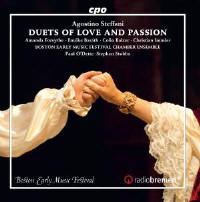Texte paru dans: / Appeared in: |
|
|
Outil de traduction ~ (Très approximatif) |
|
|
Reviewer: Barry
Brenesal Agostino Steffani (1654–1728) achieved a considerable reputation in some of the German States for his operas during his lifetime, but it was his chamber duets that gained him a select international following. While few were published, several circulated widely in manuscript among composers and patrons of the arts. Handel possessed a volume of some of these duets which he labeled “Roma 1706” for their date and place of acquisition. He later moved to Hanover, where as a young and aspiring composer, he was very kindly received by Steffani.
(Paul Henry Lang in his mammoth biography of Handel maintains that Steffani, by then Vicar Apostolic of Upper and Lower Saxony, “must have worked hard to convert Handel,” without giving any evidence why he must have, or whether he even bothered trying at all. Steffani’s sphere of operation was territorial jurisdiction of Roman Catholic Church interests within Saxony, not converting youthful composers with a reputation for truculent violence.)
All of this may seem like a lot of bother over a minor art form. But the secular cantata (a genre that includes the chamber duet) achieved enormous popularity at 17th-century courts. Very wealthy nobility might prefer to stage operas for the entertainment of their guests and themselves; but as an 18th-century monarch, Catherine Romanova, Tsarina of All the Russias, could tell you, it was an extremely expensive proposition to do this on a regular basis. One popular recourse for those wealthy enough to seek private pleasure from the operatic arts was to employ just a few singers and a small instrumental ensemble. The chamber duet was not usually the most theatrically inclined member of this clan, but the roughly 80 or so duets that Steffani composed demonstrate a mix of inspired music-making and contrapuntal expertise that was never surpassed in this form, and seldom equaled.
The Boston Early Music Festival (BEMF) first performed a work by Steffani, his opera Niobe, Regina di Tebe, back in its 2011 season, and subsequently recorded it (Erato 825646 343546; Fanfare 39:2). (Another, Orlando, is scheduled for next year.) A selection of eight of his duets was presented in concert and recorded by the BEMF folks last year. None of these selections are shared with a very fine release of seven duets featuring Arcadia, soprano Rossana Bertini, and Claudio Cavina (Glossa 80902); nor are they duplicated among the four duets included on a disc that also includes two sonatas by Caldara (Pan Classics 10131; Fanfare 33:3). The BEMF only share one duet with an album featuring Elena Bertuzzi, Alessio Tosi, and a very small accompanying ensemble (Brilliant Classics 94969; reviewed favorably in Fanfare 39:2 by Bertil van Boer).
That selection, Gelosia, che vuoi da me, shows just how much more the BEMF singers bring the music to life. Both Amanda Forsythe and Colin Balzer phrase imaginatively, with a sense of the text’s meaning. At the second stanza, where the music changes to recitative, Forsythe’s voice is more ringing, and her dynamics employed to greater effect. She sings Steffani’s figures on the words “vomita” “and inganni!” with cumulative impact. There is also a reassuring feeling of pure ease that comes from the BEMF singers, a sense that, no matter the test, these performers will always meet it without seeming ill at ease. While both Bertuzzi and Tosi are stylish singers who manage the more florid work well enough, the latter in particular is just a bit sluggish in moving his voice throughout the more melismatic passages of the first stanza. The six-piece BEMF Chamber Ensemble is also notably more inventive in its treatment of continuo than the dull if accurate playing by the older album’s three-person ensemble.
In one respect, however, the Brilliant Classics recording has an advantage over the CPO, and that’s the matter of sound. Bertuzzi and Tosi are well forward to the microphones, as is their continuo. CPO, however, puts all its performers back to a medium distance. This results in a slightly dry acoustic in which a sense of immediacy is lost, and rich overtone series dulled. The vibrancy in particular of Amanda Forsythe’s voice has been repeatedly noted in these pages by many critics, but the “radiant focus” found in Blow’s Venus and Adonis (CPO 777 614-2; Fanfare 35:2) and the “silvery tone” in Charpentier’s La descente d’Orphée (CPO 777 876-2; Fanfare 38:2) are absent. The agility and dynamic range are very much present, but there’s far more to all of these singers and instrumentalists that could have been heard if only the engineering were better. Despite this problem, I still find the music exceptional, and the performances outstanding. Recommended, with reservations noted.
| |
|
|
|
|
Cliquez l'un ou l'autre
bouton pour découvrir bien d'autres critiques de CD |
|




